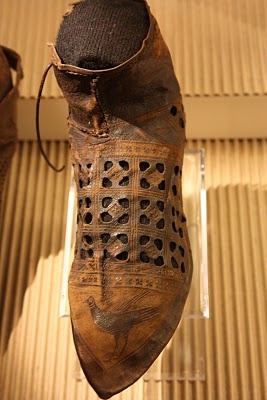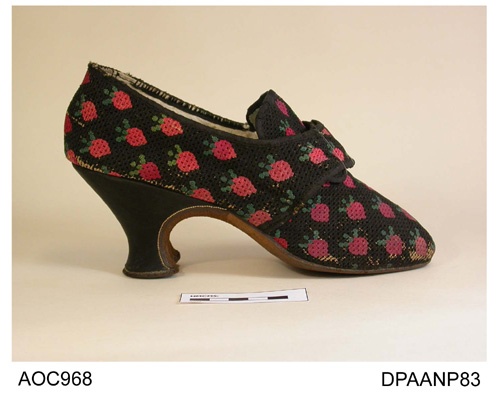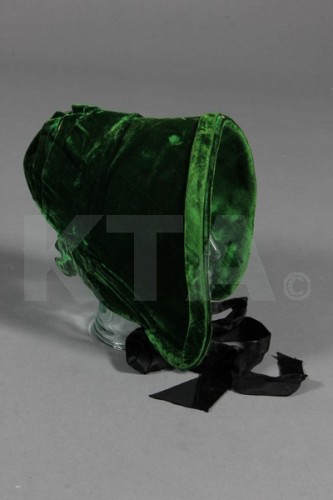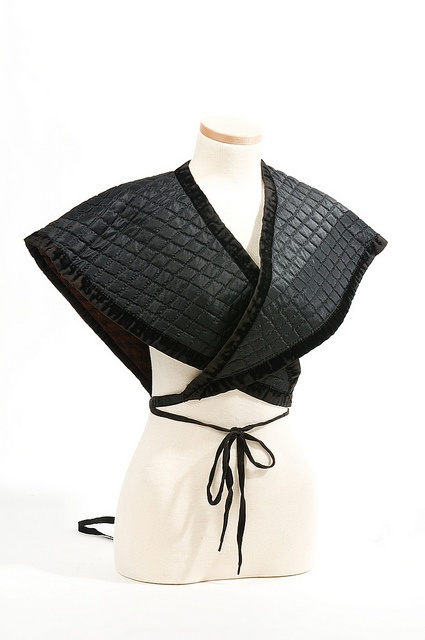The Accessorize challenge is coming up on the Historical Sew Fortnightly, and there is so much choice when it comes to what to make. So many beautiful period accessories, so many periods!
These are just a few of the items that are at the top of my ‘need an excuse to make this’ list.
First off, every girl needs a beautiful fan. I collect vintage fans – I should show you my collection. I also aim to make fans. I have hundreds I love, but one particular favourite is this spangled mid-19th century beauty. It has Greek key motifs around the brim!

Fan, 1850—60, American (probably), silk, tortoiseshell, Metropolitan Museum of Art
As you have probably realised, I’m a bit of a shoe aficionado, but there are certain pairs that just make my heart go pitter-patter with adoration. Like these:

Pair of unfinished women’s shoes, Italian, 1605—10, MFA Boston
Oh happiness in shoe form! I’ve looked into Regency sandals, but before these I hadn’t realised there might be early 17th century sandals. I want to know more about them, and I want to make them, and I don’t think the latter is entirely beyond the scope of my skills.
I must have a thing for punched leather shoes in particular, because this 14th century pair also makes me swoon (and they would also be perfect for the Flora & Fauna challenge):

Leather shoe with punchwork and bird decoration, Dutch (Haarlem), c. 1300-1350
As a seamstress, I’m fascinated by historical work-bags. I have this fantasy that one day I’ll have time to make myself one. I particularly like Marie Kundegunde’s diamond patterned (or is it mesh?) workbag. Her triple layer engageates are pretty divine as well – and technically they are an accessory too, since they would be pinned on and taken off.

Pietro Rotari (1707—1762) Portrait of Marie Kunigunde of Saxony (1740-1826), Abbess of Thorn and Essen, daughter of Augustus III of Poland, circa 1755
I don’t usually care for fruit patterned 20th century items, because the ‘vintage cherries’ trope is so over-done, but 18th century strawberry shoes? Squee! I don’t know if I’d ever have the patience to do the needlework to make my own pair (is it queen stitch?) but the right strawberry patterned fabric perhaps? Or painted? Like the bird shoes, these would also be fabulous for the Flora and Fauna challenge.

Shoes worked with strawberries 1760-1770, Hampshire City Council museum
These first-decade of the 19th century gloves just make me swoon with delight. I want to figure out how to print on kid so I can make my own! Or perhaps just draw them by hand? The figures at the top are from a series of prints of Hunchbacks – not very PC!

Gloves, 1800—1810, Spanish, leather, Metropolitan Museum of Art
Some accessories I just drool over and know I can’t every really have (like the gloves above), others are more direct inspiration. I want to make this bonnet, and the whole outfit that would go with it. Just need to find my own luscious emerald green velvet…

Bonnet, late 1830s-early 1840s, silk velvet, Kerry Taylor Auctions
Even easier is this darling 1870’s straw top hat. I’ve been remodelling a lot of modern straw hats lately, and it’s surprisingly easy (I’ll be doing a few tutorials). The trimmings really make this one.

Hat, ca. 1879 American straw, silk, Metropolitan Museum of Art
I also like accessories that could be worn with modern clothes. This chic quilted shawl is like the 19th century version of my Capelet of Yay, and I bet I’d wear it just as much!

Quilted silk shawl, mid-19th century. Charleston Museum
And finally, the award for the most fascinating and creepiest accessory ever goes to Bianca Anguisola, for her taxidermied/jewelled rodent/pig chatelaine. Seriously, what is that thing? And if I want one, is that wrong?

Sofonisba Anguissola (1530—1625), Portrait of Bianca Ponzoni Anguissola, the artist’s mother, 1557

It’s a flea fur or zibellino.
http://en.wikipedia.org/wiki/Zibellino
Oh cool! Thank you!
Angela did an awesome zibellino just a little while ago!
http://starlightmasque.livejournal.com/26654.html
Thank you (and The Dreamstress) for introducing me to a whole new thing!
Love the strawberry shoe and the colour of that bonnet is gorgeous.
I wonder if your Dutch slipper would have been worm inside klompen – wooden shoes.
I wondered that too, but it seems a shame to hide all that work. Were klompen even worn that early (pre 1630 my knowledge gets very fragmentary)?
I checked with Wikipedia, source of all knowledge – they say that the earliest examples of klompen are from the thirteenth century, but that it’s hard to get a good fix on them because broken or worn-out wooden shoes were burned as firewood. Roads weren’t paved and the mud season was intense – and animal and even human waste was underfoot.
Ordinarily, klompen are/were worn with thick fulled woolen socks, at least when they’re being worn as work footwear. From my own experience with klompen, I think leather would have been a bit slippery to walk in, whereas fiber will grab the wood and help keep your foot in the shoe.
They look more like court shoes to me, worn indoors and on paved areas.
I thought (now this is for the French sabots) that they tied cloth around the instep, thereby keeping them in place. Would slipperiness matter, then?
They do look to beautiful to be hidden in wooden shoes. Maybe indoor shoes?
You know what sort of lady would look great in that bonnet? One with dark black hair. And with a fiery personality. And someone who could go head to toe in green curtain-like velvet fabric and pretend that it was couture to see her beau… (sorry, couldn’t help it!)
Oh hush you!
I would hush, but frankly, my dear, I don’t give a damn.
If you’re wrong to want one of those chatelaines, then we are wrong together. I’d suggest the head part could be constructed with gold embroidery.
So I’ll be seeing you in the accessorise challenge then? I probably have a scrap of fur you could use to make it – and it could double as pretty much the awesomest steampunk accessory ever!
Probably Flora and Fauna; I already have something lined up for Accessorize. Thanks so much for the offer of fur! I think I have some lurking in my stash, but I may get back to you on that…
I love the green velvet bonnet!
Looks like queen stitch to me!
I wonder if that work bag was done in sprang, and then lined…
*contemplates sprang frame in closet*
Hi dreamstress
Wow, I always read your blog enjoy it. And now I see our shoe in one of your blogs! Wow, did you make that picture yourself, did you visit our museum two years ago? Because this picture was taken when it was in the special leather exhibition!BTW, we have more beautiful shoes form this period and later….
Groetjes, Anja. (town-archeaologist and head of the archeologisch museum Haarlem)
I want those lace shoes!!! They are so incredibly beautiful….